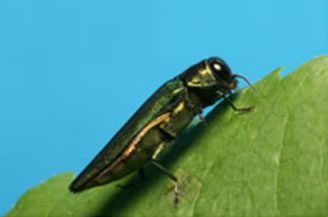Local biologist, Dr. Fred Schueler, is voicing his concern over the threat of the Emerald Ash Borer (EAB) to the natural environment in North Grenville. Fred prepared a report about the beetle for the municipality’s Environmental Advisory Committee, which detailed its increase in the Ottawa area and the significant threat it poses to the ash trees in North Grenville.
According to Wikipedia, the EAB is a type of jewel beetle and larvae feed underneath the bark to emerge as adults in one to two years. In its native area, it is typically found in low densities and doesn’t cause significant damage. However, it is an invasive species in places like Europe and North America, where it poses a significant threat to native ash trees. Local governments are currently trying to control it by monitoring its spread, diversifying tree species, using insecticides, and biological control.
When the EAB got to Ottawa, it took out almost all the Green Ash trees that had been planted to replace elms that had been killed by Dutch elm disease. However, Fred notes that, although there are a modest number of ash trees that are infested by the EAB in the municipality, it doesn’t seem to result in sudden complete mortality. A paper by Robert C. Venette and Mark Abrahamson suggests that the area is on the margin of temperatures cold enough to kill the larvae (-30 degrees Celsius). Fred also notes that a higher number of woodpeckers in some North Grenville areas may also play a role in protecting ash trees from the beetle.
Ash trees affected by the EAB stand intact for years before falling, which is caused by fungi feeding on what the beetle has left behind. Fred says that, as North Grenville trees continue to die, the potential for intact-looking trees falling across roads will become a hazard, and many roadside trees will need to be taken down. Fred also mentions that, as ash trees die, there is the potential that the invading European Buckthorn species will take over the area, inhibiting the establishment of tree seedlings and making it unlikely that other species will be able to move in to replace the dead ash. Because of this, replacement planting of a diversity of appropriate species (rare or southern) may be appropriate.
The Canadian Food Inspection Agency reported in 2018 that it has approved four species of parasitoid wasp as biological control agents for use in Canada. Fred notes that the approval of these wasps is part of a long-term strategy designed to reduce the population of the EAB in Canada. As of 2018, only three of the four species of wasp had been released in Canada, and reporting has been lax, as is common with the progress of biocontrol agents.
Resistance is something that may be more important to focus on in the local area, as some individual ash trees seem to be significantly less attractive to the EAB than others. Fred says it will be important to notice the trees that have not succumbed to the pest, so that they can be used in future breeding for resistance.
Ashes have taken over much of the area where elm trees affected by Dutch elm disease lived, and have become widespread on abandoned farmland and roadsides. Because of this, Fred says ash trees are likely the most abundant trees in North Grenville, and managing their demise and restoration is perhaps the greatest current environmental problem in the municipality. His suggestion is to focus on getting the maximum value from dying trees as fuel, and use the “coarse woody debris” as habitat for salamanders in maturing forests, while minimizing the hazards to people and maximizing the chances of recovery of ash trees and their habitat.






